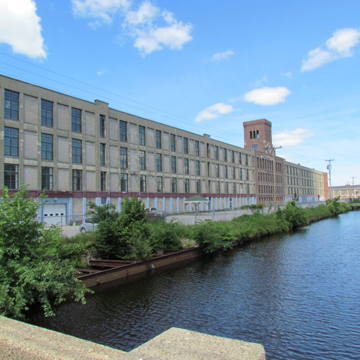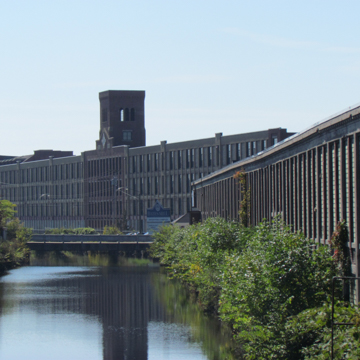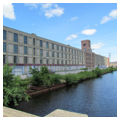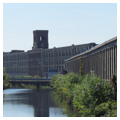You are here
Lewiston Textile Mills and Waterpower System Historic District
Lewiston’s Mill and Waterpower System historic district comprises the heart of a fairly intact industrial area dating to the 1840s. It includes not only the mill complex, canals, dams and turbines, bleachery, dye works (in 1901 the largest in the U.S.), and company housing, but also churches and other evidence of a French-Canadian migrant and immigrant culture spawned by the nineteenth-century growth of the textile industry.
While the American textile industry had its beginning in Rhode Island’s Slater Mill, and in places such as Waltham, Lowell, and Lawrence in Massachusetts, Maine’s powerful river system positioned the state to become an industrial force during the 1840s and early 1850s. Seeing the potential for cotton fabric production of Lewiston’s location at the Great Falls of the Androscoggin River, a syndicate of Boston investors including Thomas Hill, Lyman Nichols, George Ward, Alexander DeWitt, and, most importantly, Benjamin Bates, formed and chartered the Lewiston Water Power Company around 1850, which became Bates Manufacturing two years later. Astute and perspicacious enough to anticipate the Civil War, the syndicate stockpiled cotton during the 1850s, ensuring the company’s wartime profit was enormous.
Aside from water power, Lewiston also possessed the transportation system necessary for market access and a ready supply of labor. The Boston and Maine Railroad reached Portland in 1837, and the Atlantic and Saint Lawrence Railroad, later renamed the Grand Trunk, arrived in 1853, linking Montreal, Canada, to the ice-free Atlantic Ocean in Portland, and by extension, Lewiston. With the railroad, Lewiston’s textile industry further expanded and it soon became a center for the production of cotton cloth.
In 1846 and 1855 the Lewiston Water Power Company purchased all the land now comprising the downtown and in 1856 reorganized as the Franklin Company, which platted the town guided by agent Albert Kelsey. In 1850, the Lewiston Power Company hired the Massachusetts native for the design, construction, and operation of its mills and canal system. The company next hired civil engineer John B. Straw to design the water power canal and to build its company housing.
By 1866 Lewiston had 8 cotton mills, 33 water wheels, and 220,000 spindles. Its mills produced 30 million yards of cloth and employed over 3,500 female workers and 1,500 male workers, including children as well as adults. Initially, the Lewiston workforce was largely Irish, but by the 1870s, with the growing railroad network, French-Canadians migrating from Quebec comprised the central workforce. As the number of French-Canadian families grew, they sought affordable housing elsewhere, occupying rows of unadorned, clapboard-sided, triple-decker housing (common in industrial cities like Boston and Worcester) in which they occupied one floor and rented the other two. By 1900 Lewiston had become culturally Franco-American, a town anchored by its many Catholic churches. By then it was also the center of the Maine milling industry, which processed a combined total of over 65 million pounds of cotton across the state.
Textile mills were a specialized type of loft building engineered to serve a specific industry. They were designed to minimize the effects of vibration and retard the spread of fire. As technology changed, the buildings followed suit. The newly developed engaged pilaster construction in the nineteenth century provided increased wall thickness for stability and in turn allowed for larger windows to provide more light. This style, known as engaged pilaster style, was a hybrid of architecture and engineering technology. The engaged pilaster lent itself to the additional ornamentation of the Greek Revival, Italianate, and late Victorian styles seen throughout Lewiston. Due in part to their engaged pilaster construction, mills like the Continental and Androscoggin, erected during the Civil War boom, exhibit more architectural detailing than older mills. The Lewiston Machine Company exhibits wonderful Greek Revival elements such as pedimented gables, dentil courses, and molded cornices. The Continental Mill was built with two towers, each with a mansard roof mirroring the styling of the main roof. The Lewiston Mill also featured a mansard roof instead of a fourth floor; it has since lost its character-defining features, notably the top story of each of the four towers. Taken as a group, the buildings that now comprise the Lewiston Textile Mills and Water Power Systems historic district is home to some of the best examples mill architecture in northern New England. The original mills at the Bates Complex, pilastered Greek Revival mills, featured gabled roofs with cornice returns, full pediments, dentils, and capitals and bases on the pilasters.
The evolution of industrial architectural design did not end with the completion of the nineteenth-century mills. When the Bates Mill complex expanded in the twentieth century, the company turned to industrial architect Albert Kahn to design the Bates Mill No. 5 Weave Shed (1912–1914). Built to house 300 Jacquard looms, the shed was unlike any industrial structure built before in in Lewiston. It utilized reinforced concrete construction rather than wood, to create exceptionally tall and wide bays on the weave floor, and it filled the four acres of floor space with daylight filtered through a saw-tooth monitor roof.
By the second decade of the twenty-first century, much of Lewiston’s industrial district had been renovated. Sixty-five thousand square feet of the historically preserved Bates Mill (1854) has been restored into apartments, offices, restaurants, shops, services, as well as cultural institutions such as a public library and public theater.
References
Babcock, Robert H, Yves Frenette, Charles A. Scontras, and Eileen Egan. “Work and Workers in the Industrial Age, 1865-1930.” In Maine: The Pine Tree State from Prehistory to thePresent, edited by Richard Judd, Edwin A. Churchill, and Joel W. Eastman. Orono: University of Maine Press, 1995.
Reed, Roger. Historic Textile Mills in Maine: A Survey.Augusta: Maine Historic Preservation Commission, 1993.
Willis, Kate, “Lewiston Textile Mills and Waterpower System Historic District,” Androscoggin County, Maine. National Register of Historic Places Inventory-Nomination Form, 2012 [updated 2015 by Christi A. Mitchell]. National Park Service, U.S. Department of Interior, Washington, D.C.
Writing Credits
If SAH Archipedia has been useful to you, please consider supporting it.
SAH Archipedia tells the story of the United States through its buildings, landscapes, and cities. This freely available resource empowers the public with authoritative knowledge that deepens their understanding and appreciation of the built environment. But the Society of Architectural Historians, which created SAH Archipedia with University of Virginia Press, needs your support to maintain the high-caliber research, writing, photography, cartography, editing, design, and programming that make SAH Archipedia a trusted online resource available to all who value the history of place, heritage tourism, and learning.

















